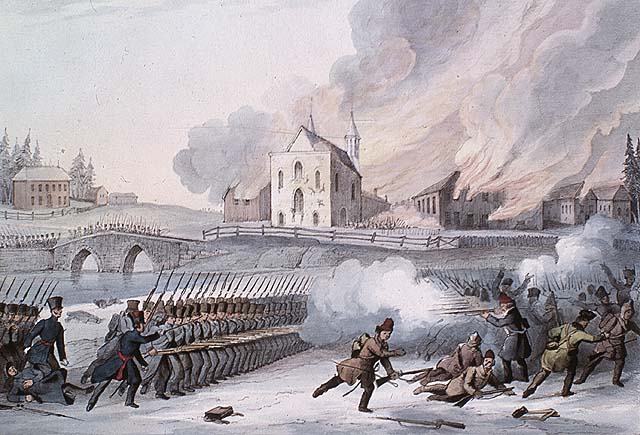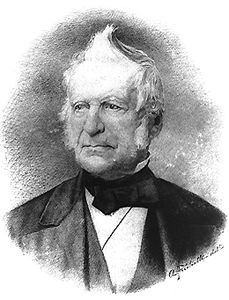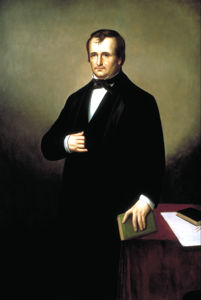In 1837 and 1838, French Canadian militants in Lower Canada took up arms against the British Crown in a pair of insurrections. The twin rebellions killed more than 300 people. They followed years of tensions between the colony’s anglophone minority and the growing, nationalistic aspirations of its francophone majority. The rebels failed in their campaign against British rule. However, their revolt led to political reform, including the unified Province of Canada and the introduction of responsible government. The rebellion in Lower Canada, which is also known as the Patriots' War (la Guerre des patriotes), also gave French Canadians one of their first nationalist heroes in Louis-Joseph Papineau.

Papineau and the Nationalists
After the War of 1812, the elected Assembly of Lower Canada (what is now Quebec), was dominated by the French Canadian middle class. Under the leadership of a new professional elite, the francophone population developed a strong sense of nationalism. Their leaders sought to take power from the Catholic Church in areas such as education. They also wanted to check the power of the anglophone merchant class. It was expanding its economic base due to the rapid growth in the timber trade. (See also: Francophone-Anglophone Relations.)
The nationalists were led by Louis-Joseph Papineau. He was elected Speaker of the Assembly in 1815. He formed the Parti Canadien, which became known as the Patriote Party after 1826. Papineau and his followers wanted to determine how the colony’s revenues were spent. They challenged the authority of the appointed upper house (the Legislative Council). They also sought control over the provincial civil service and the cabinet-like Executive Council, which advised the governor.
During the 1820s, these demands were resisted by the authoritarian Governor General of British North America, the Earl of Dalhousie. In 1828, a group of reformist British MPs wanted to come to terms with the Lower Canadian Assembly. They issued a negative report on Dalhousie’s tenure. The British Colonial Office then replaced Dalhousie with a series of more conciliatory governors: Sir James Kempt (1828–30), Lord Aylmer (1830–35) and Lord Gosford (1835–38). However, despite these efforts, the situation in Lower Canada gradually deteriorated.

Worsening Conditions and Increased Tensions
The early 1830s was a period of widespread economic distress. It was fueled by an agricultural crisis that brought many French-Canadian habitants to the verge of starvation. (See also: Habitants and French-Speaking Quebec.) At the same time, the province also saw a rapid increase in emigration from Britain. This gave the British minority close to a majority in the urban centres of Montreal and Quebec City. The immigrants brought with them the dreaded cholera epidemic. It killed many thousands of French Canadians and fed the growing prejudice of the French Canadian majority.
The 92 Resolutions
The French majority and English minority became increasingly polarized. A series of incidents increased tensions between the two communities. Chief among them was the shooting deaths of three French Canadians by British troops during an electoral riot in 1832. The Patriote Party, having lost its moderate wing and most of its anglophone support, became more extreme in its demands. This was exemplified by the 92 Resolutions adopted by the Assembly and sent to London in 1834.
The Resolutions affirmed the Assembly members’ loyalty to the Crown. However, they also listed a long series of political demands, including an increase in self-government. They wanted Lower Canada to have responsible government. This would make the Executive Council responsible to the elected Assembly and not an appointed governor.

Political Impasse
The 92 Resolutions were ignored for three years. During this time, members of the Patriotes began to agitate for rebellion. In 1837, the Legislative Assembly refused to approve money for supplies to the unelected Executive Council. As a result, the colonial government became virtually paralyzed. The civil service went unpaid and all public works ground to a halt. The anglophone minority reacted by forming constitutional associations. They also appealed to the British government to resist the Assembly.
Neither the Patriote Party nor its political opponent, the British Party, was a monolithic entity. There was more to Lower Canadian politics than “two nations warring in the bosom of a single state,” as Lord Durham described the problem in his report. But as extremists on both sides drifted toward violence, the ethnic division became more pronounced.
In March 1838, the British government passed its official response to the 92 Resolutions in London’s Parliament. The 10 Russell Resolutions (named after Britain’s Colonial Secretary, Lord Russell) rejected all the major demands of the Patriotes. They gave the governor, Lord Gosford, the power to take money from the provincial treasury to pay officials in the colony.
The Patriotes responded by organizing a boycott of British goods and holding mass protest rallies across the colony. They also began to prepare for an armed insurrection. However, there were deep divisions among the Patriote leadership over this strategy. The moderates agreed to it only in the belief that Britain would back down if faced with an uprising.

The First Rebellion: November 1837
The Patriotes fatally underestimated the resolve of the British government. It had already begun to send troops to Lower Canada from throughout the empire. It also turned a blind eye to the rifle clubs organized by anglophones. In Montreal, the militant Patriotes established the Fils de la Liberté, an independence movement with a military wing. On 6 November 1837, there was a skirmish between the Fils and the Doric Club, which represented the militant anglophones. Meanwhile, French Canadians began to practice widespread civil disobedience. British authority in the countryside rapidly deteriorated.
On 16 November 1837, the government tried to prevent the rebellion by attempting to arrest the Patriote leaders. The leaders took refuge in the countryside. On 23 November, government forces under Colonel Charles Gore suffered a minor defeat in the first major engagement of the rebellion. (See: Battle of St-Denis.) However, the Patriotes were poorly organized and lacking in equipment and leadership. They were crushed two days later by a force of British regulars under Colonel Charles Wetherall. (See: Battle of St-Charles.)
On 30 November, Gore returned to St-Denis. The town surrendered without a struggle. The soldiers sacked it, leaving 50 homes blazing. On 14 December, the British commander-in-chief, Sir John Colborne, captured St-Eustache. (See: Battle of St-Eustache.) After fierce resistance from the habitants under the leadership of Jean-Olivier Chenier, the first rebellion collapsed. There was widespread looting and burning of French-Canadian settlements by the British volunteers.

Papineau Flees, Durham Arrives
Several hundred rebels had been wounded or killed in the fighting. Many more were captured. Papineau and a number of the Patriote leaders fled to the United States. The constitution of the colony was suspended.
Lord Durham was sent to serve as the new governor general and as special commissioner. He issued an amnesty for most of the prisoners and tried to restore harmony. However, he resigned when the home government in London failed to support his measures. (See: Special Council of Lower Canada (1838–1874)).
The Second Rebellion: November 1838
With help from American sympathizers, who organized themselves into hunters’ lodges, the rebels prepared for a second insurgency. It broke out immediately after Lord Durham left in early November 1838. The rebels hoped to set off a mass uprising of the habitants by cutting communications between Montreal and the south shore of the St. Lawrence. However, the rebels were poorly organized and supplied. Led by Dr. Robert Nelson and Dr. Cyrille Côté, they were defeated at Napierville and Odelltown. One group was captured at Caughnawaga by the Iroquois, who were allied with the British.
The Patriotes defeated a small British force at Beauharnois on 9 November. They then scattered as a larger force approached. Within a week, the second outbreak had been put down, almost entirely by local volunteers. They rampaged across the country, leaving a trail of devastation. The makeshift prisons were filled with insurgent suspects. One hundred and eight men were convicted by courts-martial. Rumours of risings and invasions from the US continued, but there was no substance to them. Papineau even left the US for exile in Paris.
Between the two uprisings, 99 captured militants were condemned to death. Twelve went to the gallows, while 58 were sent to the penal colony of Australia. In total, the six battles of both campaigns left 325 dead, 27 of them British soldiers and the rest rebels. Thirteen men were executed (one by the rebels). One was murdered, one committed suicide, and two prisoners were shot.

Causes
The causes of the rebellions remain controversial. Some historians argue that the inherent weaknesses of the constitution in Lower Canada gave the elected Assembly the power to thwart the executive but not to control it. They blame the British government for failing to respond adequately to the legitimate grievances of the French-Canadian majority. But this interpretation ignores the ethnic division in Lower Canada and the economic and social tensions of the 1830s.
The underlying cause of the rebellions was the conflict between the French-Canadian majority and the British minority. (See also: Francophone-Anglophone Relations.) The French Canadians demanded that all power be centralized in the popularly elected Assembly, which it controlled. The British minority was no less determined to resist French Canadian domination.
To some extent, the Patriote leadership drifted into rebellion, which it was ill equipped to win. Many moderate French Canadians, including the hierarchy of the Catholic Church, opposed the use of force. The Church benefited from the defeat of the anticlerical Patriote leadership. Still, the revolt had widespread support among the French-Canadian population. Papineau and his lieutenants earned a lasting place in the hearts of French-Canadian nationalists.

Consequences
The influence of the radicals in the colony was eventually undermined. More moderate leaders, such as Louis-Hippolyte LaFontaine, reshaped the reform movement. The rebellions, and their more limited counterpart in Upper Canada in 1837, led directly to the appointment of Lord Durham and the Durham Report. It recommended that the Canadas be united into one colony. This was something the British minority in Lower Canada, particularly the merchant class, had long demanded. The Act of Union was passed in 1840. The united Province of Canada, which the rebel leaders had opposed, came into being in 1841. This led to the introduction of what became known as responsible government. In February 1849, the Province passed the Amnesty Act, which offered a full pardon to all those involved in the rebellions.
It is doubtful any British government could have delivered political reform, especially responsible government, to Lower Canada any sooner. There had to be some form of political union between the anglophone minority in Lower Canada and the large, anglophone population in Upper Canada. It is even more doubtful whether any union could have been forced on the French Canadians without widespread resistance. In this sense, the rebellion in Lower Canada did break the political impasse of the mid-1830s.
Some historians see the rebellions as unnecessary bloodletting that complicated and probably delayed the transition to greater self-government. However, there remains considerable sympathy for the attempts of the rebels to establish a more democratic and popular system of government in Lower Canada.

 Share on Facebook
Share on Facebook Share on X
Share on X Share by Email
Share by Email Share on Google Classroom
Share on Google Classroom



